最新Starter Unit 1 全单元教案
- 格式:doc
- 大小:72.00 KB
- 文档页数:9
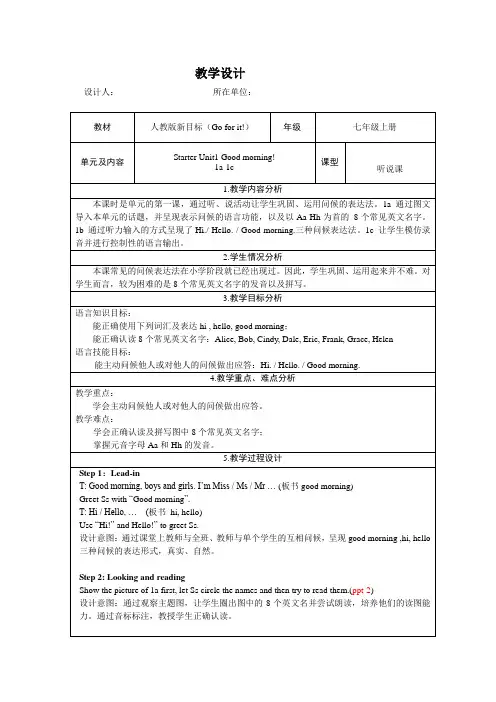
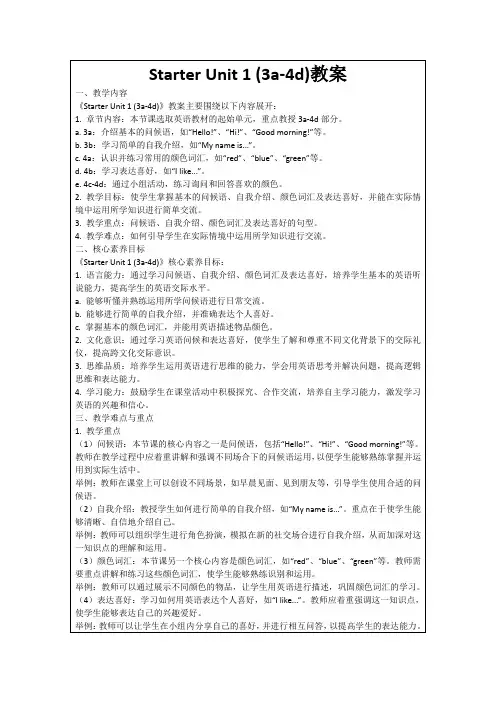
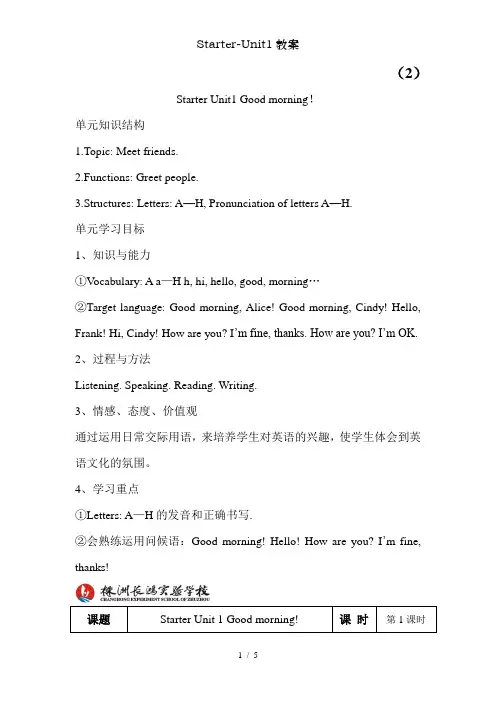
(2)Starter Unit1 Good morning!单元知识结构1.Topic: Meet friends.2.Functions: Greet people.3.Structures: Letters: A—H, Pronunciation of letters A—H.单元学习目标1、知识与能力①V ocabulary: A a—H h, hi, hello, good, morning…②Target language: Good morning, Alice! Good morning, Cindy! Hello, Frank! Hi, Cindy! How are you? I’m fine, thanks. How are you? I’m OK.2、过程与方法Listening. Speaking. Reading. Writing.3、情感、态度、价值观通过运用日常交际用语,来培养学生对英语的兴趣,使学生体会到英语文化的氛围。
4、学习重点①Letters: A—H的发音和正确书写.②会熟练运用问候语:Good morning! Hello! How are you? I’m fine, thanks!课题Starter Unit 1 Good morning! 课时第1课时课堂检测Exercises1.写出字母A---H的大小写。
2.写出下列字母的相邻字母Bb CcFf EeGg Dd3.下列字母中的是元音字母。
A.Cc B.Bb C.Ee D.Dd4.与字母F笔画一样多的是_________ 。
A. BB. dC. ED. G5.下列字母代表英国广播公司的是_________ 。
A. HBB. CDC. BBCD. ABC6.光盘缩写为。
A.HB B.kg C.BBC D.CD7.将下列字母按所含的相同音素归类。
Aa Bb Cc Dd Ee Gg Hh/eI/ ______ ______/i: / _______ ______ ______ ______ ______(3)课题Starter Unit 1 Good morning! 课时第2课时教学目标1.To learn eight persons’ name.2.To master some new words: good, morning, hi, hello, afternoon,evening…3.To learn how to greet people.教学重点To master some new words: good, morning, hi, hello, afternoon…To learn to greet people.教学难点To master some new words: good, morning, hi, hello, afternoon…To learn to greet people.。
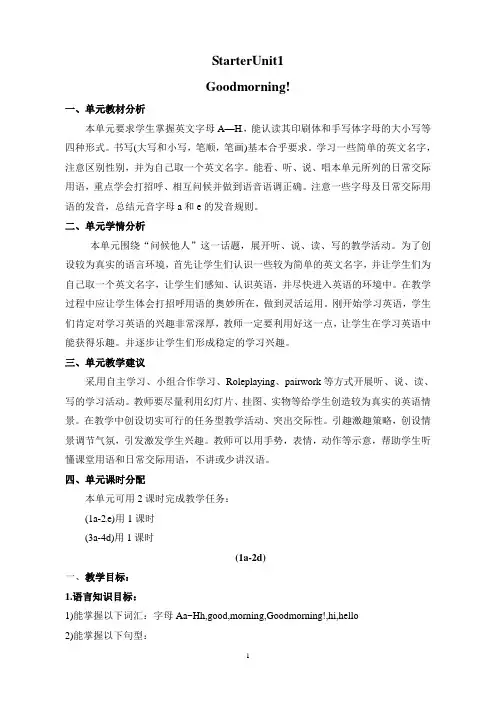
StarterUnit1Goodmorning!一、单元教材分析本单元要求学生掌握英文字母A—H,能认读其印刷体和手写体字母的大小写等四种形式。
书写(大写和小写,笔顺,笔画)基本合乎要求。
学习一些简单的英文名字,注意区别性别,并为自己取一个英文名字。
能看、听、说、唱本单元所列的日常交际用语,重点学会打招呼、相互问候并做到语音语调正确。
注意一些字母及日常交际用语的发音,总结元音字母a和e的发音规则。
二、单元学情分析本单元围绕“问候他人”这一话题,展开听、说、读、写的教学活动。
为了创设较为真实的语言环境,首先让学生们认识一些较为简单的英文名字,并让学生们为自己取一个英文名字,让学生们感知、认识英语,并尽快进入英语的环境中。
在教学过程中应让学生体会打招呼用语的奥妙所在,做到灵活运用。
刚开始学习英语,学生们肯定对学习英语的兴趣非常深厚,教师一定要利用好这一点,让学生在学习英语中能获得乐趣。
并逐步让学生们形成稳定的学习兴趣。
三、单元教学建议采用自主学习、小组合作学习、Roleplaying、pairwork等方式开展听、说、读、写的学习活动。
教师要尽量利用幻灯片、挂图、实物等给学生创造较为真实的英语情景。
在教学中创设切实可行的任务型教学活动、突出交际性。
引趣激趣策略,创设情景调节气氛,引发激发学生兴趣。
教师可以用手势,表情,动作等示意,帮助学生听懂课堂用语和日常交际用语,不讲或少讲汉语。
四、单元课时分配本单元可用2课时完成教学任务:(1a-2e)用1课时(3a-4d)用1课时(1a-2d)一、教学目标:1.语言知识目标:1)能掌握以下词汇:字母Aa~Hh,good,morning,Goodmorning!,hi,hello2)能掌握以下句型:①Goodmorning,Helen!②Hello,Frank!③Hi,Bob!3)能理解用英语打招呼的不同说法,并能灵活运用。
4)能掌握字母Aa~Hh的字母顺序,读音及书写。
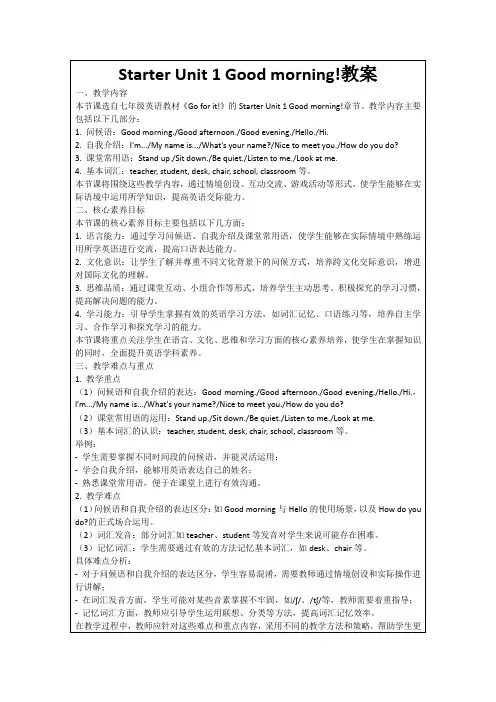
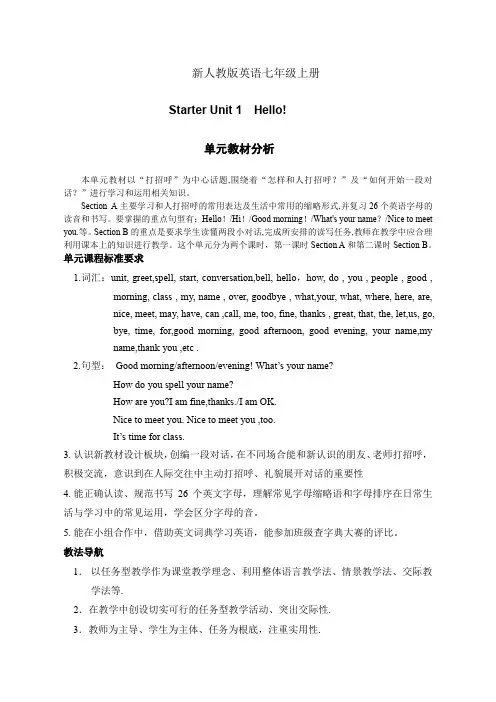
新人教版英语七年级上册Starter Unit 1Hello!单元教材分析本单元教材以“打招呼”为中心话题,围绕着“怎样和人打招呼?”及“如何开始一段对话?”进行学习和运用相关知识。
Section A主要学习和人打招呼的常用表达及生活中常用的缩略形式,并复习26个英语字母的读音和书写。
要掌握的重点句型有:Hello!/Hi!/Good morning!/What's your name?/Nice to meet you.等。
Section B的重点是要求学生读懂两段小对话,完成所安排的读写任务,教师在教学中应合理利用课本上的知识进行教学。
这个单元分为两个课时,第一课时Section A和第二课时Section B。
单元课程标准要求1.词汇:unit, greet,spell, start, conversation,bell, hello,how, do , you , people , good ,morning, class , my, name , over, goodbye , what,your, what, where, here, are,nice, meet, may, have, can ,call, me, too, fine, thanks , great, that, the, let,us, go,bye, time, for,good morning, good afternoon, good evening, your name,myname,thank you ,etc .2.句型:Good morning/afternoon/evening! What’s your name?How do you spell your name?How are you?I am fine,thanks./I am OK.Nice to meet you. Nice to meet you ,too.It’s time for class.3.认识新教材设计板块,创编一段对话,在不同场合能和新认识的朋友、老师打招呼,积极交流,意识到在人际交往中主动打招呼、礼貌展开对话的重要性4.能正确认读、规范书写26个英文字母,理解常见字母缩略语和字母排序在日常生活与学习中的常见运用,学会区分字母的音。
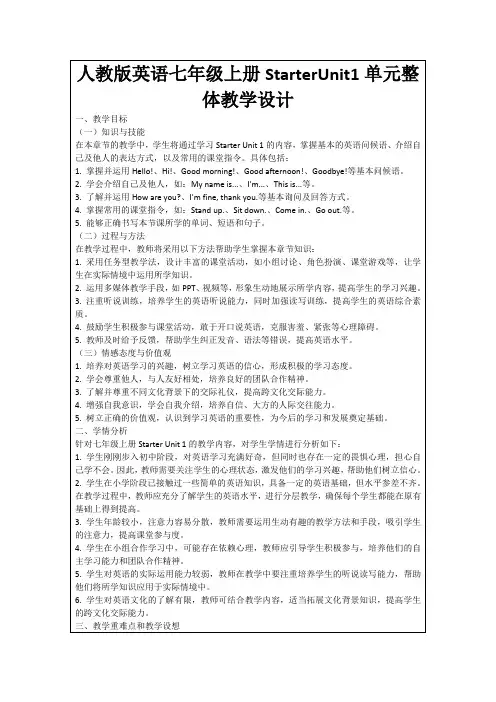
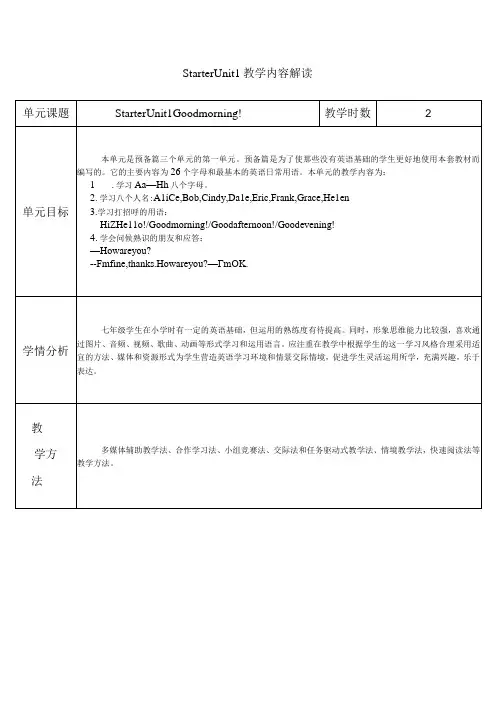
StarterUnit1教学内容解读
第二课时:(3a—4d)
单元知识框架Z X
1esson1听说课
V ___________ √
内容:将字母学习和
英语的问候及应答话
题学习相结合。
1esson1
字母书写课
主题意义:激发学
生学习字母以及
学习英语的兴趣,
让他们认识到字
母在生活中的重
要性。
聚焦能力:通
过听获取信
息的能力以
及口语表达
能力O
内容:通过听力
练习和对话训练,
进行互致问候的
语言交流活动,
并且了解A、E
在重读开、闭音
节中的读音。
主题意义:在对
话中学会运用
所学知识。
聚焦能力:探究
学习,归纳总结
的能力。
\ ____________ √
课
时
计
划
第一课时(1a—2e)
StarterUnit1教学设计
StarterUnit1教学设计。
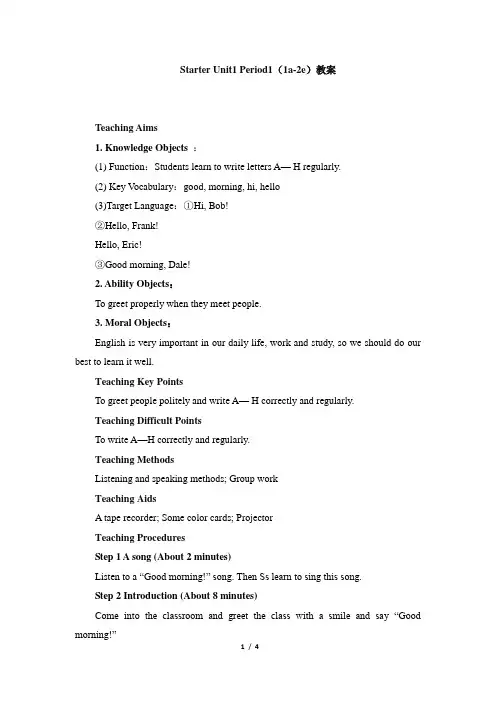
Starter Unit1 Period1(1a-2e)教案Teaching Aims1. Knowledge Objects:(1) Function:Students learn to write letters A— H regularly.(2) Key V ocabulary:good, morning, hi, hello(3)Target Language:①Hi, Bob!②Hello, Frank!Hello, Eric!③Good morning, Dale!2. Ability Objects:To greet properly when they meet people.3. Moral Objects:English is very important in our daily life, work and study, so we should do our best to learn it well.Teaching Key PointsTo greet people politely and write A— H correctly and regularly.Teaching Difficult PointsTo write A—H correctly and regularly.Teaching MethodsListening and speaking methods; Group workTeaching AidsA tape recorder; Some color cards; ProjectorTeaching ProceduresStep 1 A song (About 2 minutes)Listen to a “Good morning!” song. Then Ss learn to sing this song.Step 2 Introduction (About 8 minutes)Come into the classroom and greet the class with a smile and say “Good morning!”Now, introduce the words “teacher” and “class” by using gestures. Repeat this several times and have the class repeat after you. You may want to leave the class and come in again to introduce the usual “Good morning” routine. Say “Good morning, class”. Help students respond with “Good morning”. Point to yourself and say “I’m Miss/Mr.”… Have them repeat. Explain the terms Miss and Mr. in Chinese.Repeat this a few times with rows and individuals.Miss, Mr.…(Ss repeat)Morning, Miss/Mr.… (Ss repeat)Good morning, Miss, Mr.…(Ss repeat)Step 3 Listen and repeat (About 5 minutes).1. T: Open your books, turn to page 1. There are 8 students in the picture. (按图片上的人物数)One, two, three, four, five, six, seven, eight. Their names are:Grace, Bob, Dale, Helen, Eric, Frank, Cindy and Alice. (可以通过大屏幕展示第一页上的彩图,然后再展示单张图片,并分别与名字相对应。
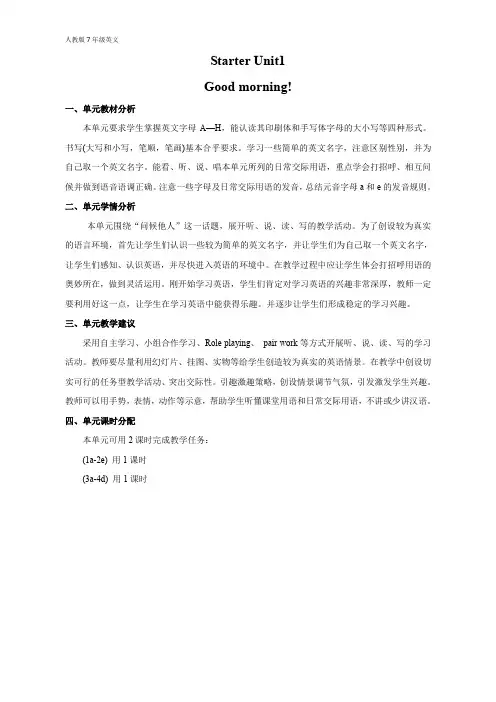
Starter Unit1Good morning!一、单元教材分析本单元要求学生掌握英文字母A—H,能认读其印刷体和手写体字母的大小写等四种形式。
书写(大写和小写,笔顺,笔画)基本合乎要求。
学习一些简单的英文名字,注意区别性别,并为自己取一个英文名字。
能看、听、说、唱本单元所列的日常交际用语,重点学会打招呼、相互问候并做到语音语调正确。
注意一些字母及日常交际用语的发音,总结元音字母a和e的发音规则。
二、单元学情分析本单元围绕“问候他人”这一话题,展开听、说、读、写的教学活动。
为了创设较为真实的语言环境,首先让学生们认识一些较为简单的英文名字,并让学生们为自己取一个英文名字,让学生们感知、认识英语,并尽快进入英语的环境中。
在教学过程中应让学生体会打招呼用语的奥妙所在,做到灵活运用。
刚开始学习英语,学生们肯定对学习英语的兴趣非常深厚,教师一定要利用好这一点,让学生在学习英语中能获得乐趣。
并逐步让学生们形成稳定的学习兴趣。
三、单元教学建议采用自主学习、小组合作学习、Role playing、pair work等方式开展听、说、读、写的学习活动。
教师要尽量利用幻灯片、挂图、实物等给学生创造较为真实的英语情景。
在教学中创设切实可行的任务型教学活动、突出交际性。
引趣激趣策略,创设情景调节气氛,引发激发学生兴趣。
教师可以用手势,表情,动作等示意,帮助学生听懂课堂用语和日常交际用语,不讲或少讲汉语。
四、单元课时分配本单元可用2课时完成教学任务:(1a-2e) 用1课时(3a-4d) 用1课时(1a-2d)一、教学目标:1. 语言知识目标:1) 能掌握以下词汇:字母Aa ~ Hh, good, morning, Good morning!, hi, hello2) 能掌握以下句型:①Good morning, Helen!②Hello, Frank!③Hi, Bob!3) 能理解用英语打招呼的不同说法,并能灵活运用。
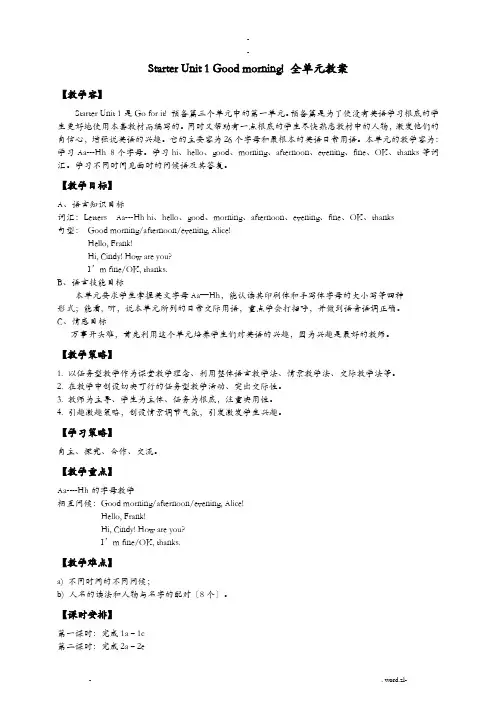
Starter Unit 1 Good morning! 全单元教案【教学容】Starter Unit 1是Go for it! 预备篇三个单元中的第一单元。
预备篇是为了使没有英语学习根底的学生更好地使用本套教材而编写的。
同时又帮助有一点根底的学生尽快熟悉教材中的人物,激发他们的自信心,增强说英语的兴趣。
它的主要容为26个字母和最根本的英语日常用语。
本单元的教学容为:学习Aa---Hh 8个字母。
学习hi、hello、good、morning、afternoon、evening、fine、OK、thanks等词汇。
学习不同时间见面时的问候语及其答复。
【教学目标】A、语言知识目标词汇:Letters Aa---Hh hi、hello、good、morning、afternoon、evening、fine、OK、thanks句型:Good morning/afternoon/evening, Alice!Hello, Frank!Hi, Cindy! How are you?I’m fine/OK, thanks.B、语言技能目标本单元要求学生掌握英文字母Aa—Hh,能认读其印刷体和手写体字母的大小写等四种形式;能看, 听,说本单元所列的日常交际用语,重点学会打招呼,并做到语音语调正确。
C、情感目标万事开头难,首先利用这个单元培养学生们对英语的兴趣,因为兴趣是最好的教师。
【教学策略】1. 以任务型教学作为课堂教学理念、利用整体语言教学法、情景教学法、交际教学法等。
2. 在教学中创设切实可行的任务型教学活动、突出交际性。
3. 教师为主导、学生为主体、任务为根底,注重实用性。
4. 引趣激趣策略,创设情景调节气氛,引发激发学生兴趣。
【学习策略】自主、探究、合作、交流。
【教学重点】Aa----Hh的字母教学相互问候:Good morning/afternoon/evening, Alice!Hello, Frank!Hi, Cindy! How are you?I’m fine/OK, thanks.【教学难点】a) 不同时间的不同问候;b) 人名的读法和人物与名字的配对〔8个〕。
七年级英语starter1名师教案英语教案设计总是以某种教学理论为依据的。
下面是小编为大家精心整理的七年级英语starter1名师教案,仅供参考。
七年级英语starter1名师教案范文Unit 1 Good morning!一.教材分析Go for it!学生用书每个单元包括Section A, Section B 和Self Check三个部分。
它将话题,功能和交际巧妙地融合在一起,用一种循序渐进的生活化的学习程序引导学生把所学的语言知识和实际运用结合起来。
SectionA 为基本的语言内容,并为目标句型提供分步示例和指导性练习;Section B是知识的扩展和综合的语言运用,使学生能够对已经学过的目标句型运用自如;Self Check 供学生用来自我检测本单元所学的语言知识,使学生对现阶段的英语水平,即对本单元的语言目标有较为明确的认识。
它的编排虽然仍以单元为单位,但是以TBL语言教学模式的板块设计,为课堂教学的灵活组织留下了更大的空间。
Starter Unit 1 是Go for it!预备篇三个单元的第一单元。
预备篇是为了使那些没有英语基础的学生更好地使用本套教材而编写的。
它的主要内容为26个字母和最基本的英语日常用语。
本单元的教学内容为:1. 学习Aa --- Hh八个字母。
2. 学习八个人名。
Alice, Bob, Cindy, Dale, Eric, Frank, Grace, Helen3. 学习打招呼的用语:Hello!/ Good morning!/ Good afternoon!/ Good evening!4. 学会问候熟识的朋友和应答:-- How are you?-- I’m fine, thanks. How are you? -- I’m OK.二.教学设计思路Go for it!是以«英语课程标准»为依据,以培养学生的英语语言综合运用能力为目标,每个单元的教学内容都围绕一个话题,让学生在完成各项任务的过程中学会语言,真正体现:“Learn by doing. Learn by using.‖ 这一教学原则。
Unit 1 Good morning!I. Teaching Contents: Unit 1 Good morning!II: Analysis of the Teaching Material1.Status and FunctionThe topic of this unit is about meeting friends, and the students will learn to practice some English names, common English greetings and the letters Aa-Hh. 2.Teaching Aims and Demands(1)Knowledge Objectsa.To master the letters A-H.b.To master the common English greetings.(2)Ability ObjectsTo improve students’ ability of listening, speaking and writing.3.Teaching Difficult PointsTo master the key vocabulary and the target language presented in this unit.4.Teaching focuses(1)To learn how to read and write the letters Aa-Hh.(2)To learn how to greet in English.(3)To do listening exercises.III. Language FunctionTalk about how to greet people.IV. Target LanguageGood morning, good afternoon, good evening, hi, helloHow are you? I’m fine, thanks.Letters Aa-Hh.V. VocabularyAa, Bb, Cc, Dd, Ee, Ff, Gg, Hhgood, morning, afternoon, evening, hi, hello, fine, OK, thanksVI. Teaching TimeFive periods1. Introduce the children and their names in the picture on page1. Bob Grace Helen Cindy Alice Eric Frank Dale2. Extending: teach more English namesLinda Jenny Gina Mary Jim Tony Tom Sally Mona Step 4. ActivityLet students choose their favorite English names for themselves. Step 5. Listening practiceSB page1 Activity 1a Listen and repeat.Step 6. PresentationReview the letters Aa-Hh.Step 2.PracticeConsolidate the pronunciation and writing of letters through exercises:1.SB page2 Activity 2c Listen and number the letters.2.SB page2 Activity 2d Write the small letters for the big letters.Step 3. Pairwork1. Show the student a CD and ask them if they know what it is. Discusswhat these letters (HB, CD, BBC) mean in pairs.2. Encourage the students to care what kind of English they can find in theIII. Teaching DifficultiesKey structure & PairworkIV Teaching ProceduresStep 1.PresentationPresent a conversation:A: Hi, Helen! How are you?B: Hi, Cindy! I’m fine, thank you. / I’m OK.Step 2. Listening practiceSB page4 Activity1 Listen to the conversation, then practice withStep 1. Revision1.Review how to greet people formally and informally;2.Review the letters A-H.Step 2. PracticeConsolidate the pronunciation and writing of letters through exercises:1.SB page5 Activity 2c Listen and draw lines between the letters.2.SB page5 Activity 2c Match the big letters with small letters. Step3. Listening practiceListen and repeat. Pay attention to the pronunciation of letters A, E..A:What’s your name?B:____________ ..A:Sit down,please.B:___________..A:What’s this?B:__________.a.It’s“B”.b.Good morning,teacher.c.Fine,thank you.d.My name is Jim.e.Thank you.五、补全对话Unit 2 What’s this in English?I. Teaching Contents: Unit 2 What’s this in English?II: Analysis of the Teaching Material1.Status and FunctionIn this unit students learn to ask how to say and spell words in English and the letters Ii-Rr. The topic of this unit is about things around people, and the students can learn how to identify things.Teaching Aims and Demandsa)Knowledge Objects(1) To master the letters I-R;(2) To master how to identify things and spell words;(3) To learn “what” question.b)Ability ObjectsTo improve students’ ability of listening, speaking and writing.2.Teaching Difficult Points(1) To master the key vocabulary and the target language presented in this unit;(2) Pronunciation of letters A, E, I, O;(3) Listening and speaking practice.3.Teaching focuses(1)To learn how to read and write the letters Ii-Rr;(2)To learn “what” question;(3)To learn to ask how to say and spell words.III. Language FunctionTalk about how to identify things and spell wordsIV. Target LanguageWhat’s this in English?It’s a key.Spell it, please.K-E-Y.V. VocabularyIi, Jj, Kk, Ll, Mm, Nn, Oo, Pp, Qq, Rrjacket, key, map, orange, pen, quilt, ruler, spellVI. Teaching TimeFive periodsLet the students greet each other and introduce themselves in English.Step 2. PresentationPresent a conversation and practice it with the help of a map.What’s this in English?It’s a map/an orange.Step 3. Listening practiceSB page7 Activity1a Listen to the conversation.Then let the students act out the conversations in pairs. Make sure the students understand what they should do.Step 1.RevisionReview the letters I-R.Step 2.PracticeConsolidate the pronunciation and writing of letters through exercises:1. Listen and number the letters they hear.2. SB page8 Activity 2d Write the small letters for the big letters.Step 3. Groupwork1. Discuss what these letters (P, NBA, kg) mean in groups.2. Ask the students to say out where we can find English words or EnglishIII. Teaching DifficultiesTarget langluage & PairworkIV Teaching ProceduresStep 1. PresentationPresent a conversation with the help of a key.T: What’s this in English? S: It’s a key.T: Yes, it’s a key. K-E-Y, key. We can spell it K-E-Y.Step 2. PairworkPractice the dialogue by using other different words in pairs, such as:Pronunciation of letters A, E, I, O & Self-checkIV Teaching proceduresStep1 Free talkLet the students make free talk about the things in the classroom.Step 2.RevisionReview the letters Aa-Rr.Step 3.Listening practiceSB page11 Activity3a Play the tape and check the answers.Step 4. Pairwork)3.What’s your name? c.Dale is.)4.How are you,Jim? d.Hello!)5.What’s this? e.Thank you.)6.Sit down,please.f.Good morning.g.It’s“M”.四、选择填空)1.This is ______ nice jacket.A.an B.a C.one D./)2.What’s that _______in Chinese?Unit3 What color is it ?、要求掌握以下字母:Ss T t V v V v W w X x Y y Z z、要求掌握以下词汇:red green blue yellow white black Teaching steps、warming- up and revision (课前热身和复习))Daily greetings to the students (日常问候):Good morning/afternoon:It’s red .通过这个句型引出要学的新字母和六种颜色,可以做字母卡片,并在每个字母上涂上一种要学的颜色。
新目标英语Starter Unit教案一、教学目标1. 知识目标(1)学生能够听懂并准确朗读Starter Unit中的单词和句子。
(2)学生能够理解并运用Starter Unit中的日常交际用语。
(3)学生能够简单介绍自己的姓名、年龄、年级和学校。
2. 能力目标(1)学生能够通过听、说、读、写的训练,提高英语交际能力。
(2)学生能够通过小组合作,提高团队合作能力。
3. 情感目标(1)激发学生学习英语的兴趣和积极性。
(2)培养学生热爱生活、积极向上的心态。
二、教学内容1. 单词:hello, good morning, good afternoon, good evening, how are you, I'm fine, thank you, are they, yes, no, what's your name, my name is, nice to meet you, e e2. 句子:介绍自己的姓名、年龄、年级和学校三、教学重点与难点1. 重点:单词的准确认读与书写,句子的正确运用。
2. 难点:日常交际用语的运用,介绍自己的姓名、年龄、年级和学校。
四、教学方法1. 情境教学法:通过设定生活情境,让学生在实际语境中学习并运用英语。
2. 交际法:引导学生进行角色扮演,提高英语交际能力。
3. 小组合作学习:培养学生团队合作精神,提高口语表达能力。
五、教学步骤1. 热身活动(5分钟)(1)教师与学生用中文进行简单的自我介绍。
(2)学生相互之间用中文进行自我介绍。
2. 引入新课(10分钟)(1)教师展示Starter Unit的图片,引导学生看图说话。
(2)教师逐个教单词,学生跟读。
3. 学习句子(10分钟)(1)教师展示Starter Unit的句子,学生跟读。
(2)教师引导学生进行角色扮演,运用所学句子进行交际。
4. 实践活动(10分钟)(1)学生分成小组,用英语进行自我介绍。
Starter Unit 1 Good morning!一、Teaching Content:Section A二、Analysis of teaching material and learnersThe main task for students for the whole unit is to learn to use English letters and know some English names and how to use simple words to greet people.For seven grade students,greeting people is a interesting topic,and it's relate to their life and they have the ability to learn new words and sentences.三、Teaching objectives1. Knowledge Objects(1) V ocabulary:8 Letters: Aa---HhEnglish names: Alice, Bob, Cindy, Dale, Eric, Frank, Grace, Helen(2) Sentence:Hi!/Hello!/ Good morning!/ Good afternoon!/ Good evening!2. Skills Objects(1) learn to how to use 8 English letters(2) learn to greet people in different time3. Affect ObjectsHelp student to develop the interest of learning English and good habit to be polite to others,and learn to work in groups as well as cooperate with others and enjoy join the activities in class四、Teaching focus and difficulties1. Teaching focus(1). Be able to listen、speak、read and write 8 letters(2). Be able to learn how to use the simple sentences to greet people in the daily life:--Good morning, Helen!--Hi, Bob!--Hello, Frank! Hello, Eric!--Good morning, Dale!2. Teaching difficulties(1). Remember the English names write the 8 letters correctly(2). Use sentences to greet friends in different time and answer others’ greeting五、Teaching procedureStep 1. Warming-upGreet all the Students with : Good morning, boys and girls.Let students answer “Good morning, teacher”.Step 2. Presentation1. Show different letters on the slide picture and see if they can read them.2. Listening to a English song 26 letters,whole class sing the song together.S tep 3. Learn the letters.1. Listen and repeat the eight letters.2. Teach them how to write these big and small letters.3. Let students write the eight letter friends in blackboard or their text books.Step 4. Learn English names.1. Show pictures on the slide and tell students to meet new friends and read the names one by one.2. Use interesting way to remember these new names3. Review the letters and names and find out the relationship between them4. Let student select a English name for themselves.Step 5. Listen and repeat.1. Listen to the dialogue and follow it.2. PairworkStep 6. Greet people1. Explain the use of good morning, hello, hi.2. Explain the use of greeting words in different time.Step 7. ExerciseAsk students finish the works in groups or in individual.Step 8. Homework1. Write the 8 letters and the dialogue in Section A1a.2. Recite the new words and dialogue in Section A1a and Make up dialogues like the ones in e your own English names.六、Blackboard design。
Starter Unit 1 Good morning! 全单元教案【教学内容】Starter Unit 1是Go for it! 预备篇三个单元中的第一单元。
预备篇是为了使没有英语学习基础的学生更好地使用本套教材而编写的。
同时又帮助有一点基础的学生尽快熟悉教材中的人物,激发他们的自信心,增强说英语的兴趣。
它的主要内容为26个字母和最基本的英语日常用语。
本单元的教学内容为:学习Aa---Hh 8个字母。
学习hi、hello、good、morning、afternoon、evening、fine、OK、thanks 等词汇。
学习不同时间见面时的问候语及其回答。
【教学目标】A、语言知识目标词汇:Letters Aa---Hh hi、hello、good、morning、afternoon、evening、fine、OK、thanks句型:Good morning/afternoon/evening, Alice!Hello, Frank!Hi, Cindy! How are you?I’m fine/OK, thanks.B、语言技能目标本单元要求学生掌握英文字母Aa—Hh,能认读其印刷体和手写体字母的大小写等四种形式;能看, 听,说本单元所列的日常交际用语,重点学会打招呼,并做到语音语调正确。
C、情感目标万事开头难,首先利用这个单元培养学生们对英语的兴趣,因为兴趣是最好的老师。
【教学策略】1. 以任务型教学作为课堂教学理念、利用整体语言教学法、情景教学法、交际教学法等。
2. 在教学中创设切实可行的任务型教学活动、突出交际性。
3. 教师为主导、学生为主体、任务为基础,注重实用性。
4. 引趣激趣策略,创设情景调节气氛,引发激发学生兴趣。
【学习策略】自主、探究、合作、交流。
【教学重点】Aa----Hh的字母教学相互问候:Good morning/afternoon/evening, Alice!Hello, Frank!Hi, Cindy! How are you?I’m fine/OK, thanks.【教学难点】a) 不同时间的不同问候;b) 人名的读法和人物与名字的配对(8个)。
【课时安排】第一课时:完成1a–1c第二课时:完成2a–2e第三课时:完成3a–3d第四课时:完成4a–4d【教学过程】The First Period (1a–1c)Teaching aims (教学目标)1. 能识别书中的八个人物。
2. 学会八个人名的读音。
3. 学会早上见面打招呼的用语。
Language points (语言点)1. 词汇:1) 名词n.:morning, Alice, Bob, Cindy, Dale, Eric, Frank, Grace, Helen2)形容词adj. :good3) 感叹词interj. :hi, hello2. 句型:Hello! Good morning!Difficulties (教学难点):1. 八个英语名字的正确发音;2. 字母A, C, G, H的正确发音Teaching steps (教学步骤)Step 1. Warm-up (课堂热身)1. Listen to an English song: Good morning to you!2. Teach everyday English:--Class begins!--Stand up !--Good morning, class!--Good morning, Miss Wang!--Sit down, please!--Thank you!【教学设计说明】师生初次见面,教师通过自我介绍和问候学生,让学生放轻松,消除与教师间的陌生感,开始亲近教师。
Step 2. Presentation (呈现新知识)1. Let’s meet some new friends.Show the picture on page S1 on the PPT and help Ss to learn to pronounce the names. Say,Here are some students. Let’s look learn their names. (通过幻灯片一个一个地出现课文中人物的图片)【教学设计说明】此设计是让学生初步认识课文中的人物,了解他们的名字,为下一步的学习奠定基础。
Step 3. Work on 1a (完成1a)(1) Show the picture on page S1 on the PPT. (此步骤不出现问候语)(2) Point to the persons and have Ss say their names.(3) Say one of the names and have Ss repeat it, and then write it below Boys’ nam e s or Girls’ names in the book.(4) Check Ss’ answers.【教学设计说明】此步骤的设计不但是让学生反复熟悉书上的英文名,同时,把这些英文名送给那些能大胆回答问题的学生,以示奖励,这样可增强学生学习英语的信心。
Step 4. Presentation (呈现新知识)Show a picture with Bob and Helen and have Ss guess what Bob would say to Helen. The answer may be: Hello, Helen! or Good morning, Helen!【教学设计说明】通过图画上的场景让学生进行猜测,满足学生的好奇心,也让他们了解Good morning 的使用。
Step 5. Work on 1b (完成1b)(1) Play the recording for the first time. Ss only listen.(2) Play the recording for the second time. Students listen and repeat.(3) Play the recording for the third time. Students look, listen and repeat.T: Now please open your books to page S1. You can look at the conversations in yo ur book. Let’s listenand repeat.【教学设计说明】此步骤的设计是让学生接触到地道的英语,先听后说,练习正确的语音语调,养成学习英语的良好习惯。
Step 6. Work on 1c (完成1c)(1)Have Ss practice reading the conversations in the picture in pairs. Move around the classroom when Ss are practicing. Give them help if needed.(2)Greet Ss using their English names. The other Ss listen, watch and learn.(3)Students practice greeting each other. They can use their Chinese names if they wish. Encourage them to use their English names if they can.(4)T: Now I’ll ask some pai rs to say your conversation to the class.【教学设计说明】此设计主要是鼓励学生尽可能用自己刚才得到的英语名字进行操练,也允许他们使用自己的中文名字进行练习,其目的是鼓励学生大胆开口,开始养成愿意说的良好习惯。
Step 7. Language points:一、good morning, 常用于早晨或上午(中午12点之前)向他人问候。
如果对方是我们熟悉的人,还可以说:“Morning!”。
当然,还可以用“Hello!”或“Hi!”来打招呼。
回答时,可以重复对方的话,也可以向其进行问候。
在不同的时间段,还可以说:Good afternoon! 下午好!Good evening! 晚上好!二、hello是人们见面时常用的问候语,有时为了引起对方注意也用hello, 意为“喂”、“你好”。
hi可与之互换,不过,hi比hello更常用,显得更亲近、随和。
它们都用于口语,使用时不受时间的限……三、How are you? 是英美国家较熟悉的人之间见面时常用的问候语,但并不是想深入交谈某人的健康状况,只是一种礼貌的问候方式,常见的答语为:Fine, thank you. / Very well. ( I’m OK. / I’m all right. ) thank you./ Thanks.出于礼貌并常加上一句And you? (你呢?)来询问对方。
这时,可以用:I’m fine, too./ Fine, too./ Not (too) bad, thank you.等作答。
Step 8. Homework (课后作业)The Second Period (2a–2e)Teaching aims (教学目标)1. 学会正确朗读和书写A a–H h 八个字母。
2. 了解缩略字母HB, CD, BBC的含义。
3. 巩固所学的八个人名和问候语4. 记住自己和同伴的英文名字。
Language points (语言点)词汇:自己和同伴的英文名字Difficulties (难点):1. 字母A, C, G, H的正确发音2. 字母A a—H h 的正确书写Teaching steps (教学步骤)Step 1. Warm-up and revision(课堂热身和复习)(1)Play the “Good morning!” song on page S4 before the class starts.(2)Greetings:T: Class begins. Stand up! Good morning, everyone!Ss: Good morning, Mr./Mrs./Ms/Miss ...T: Sit down, please.Ss: Thank you.T: Good morning, ... ! (教师课前要求学生把自己制作的姓名卡放在桌上,与学生打招呼时说出他们的英文名,以帮助学生记住自己的英文名读音。